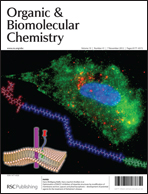Chemical methods to interrogate bacterial quorum sensing pathways
Abstract
Bacteria frequently manifest distinct phenotypes as a function of cell density in a phenomenon known as quorum sensing (QS). This intercellular signalling process is mediated by “chemical languages” comprised of low-molecular weight signals, known as autoinducers, and their cognate receptor proteins. As many of the phenotypes regulated by QS can have a significant impact on the success of pathogenic or mutualistic prokaryotic–eukaryotic interactions, there is considerable interest in methods to probe and modulate QS pathways with temporal and spatial control. Such methods would be valuable for both basic research in bacterial ecology and in practical medicinal, agricultural, and industrial applications. Toward this goal, considerable recent research has been focused on the development of chemical approaches to study bacterial QS pathways. In this Perspective, we provide an overview of the use of chemical probes and techniques in QS research. Specifically, we focus on: (1) combinatorial approaches for the discovery of small molecule QS modulators, (2) affinity chromatography for the isolation of QS receptors, (3) reactive and fluorescent probes for QS receptors, (4) antibodies as quorum “quenchers,” (5) abiotic polymeric “sinks” and “pools” for QS signals, and (6) the electrochemical sensing of QS signals. The application of such chemical methods can offer unique advantages for both elucidating and manipulating QS pathways in culture and under native conditions.


 Please wait while we load your content...
Please wait while we load your content...